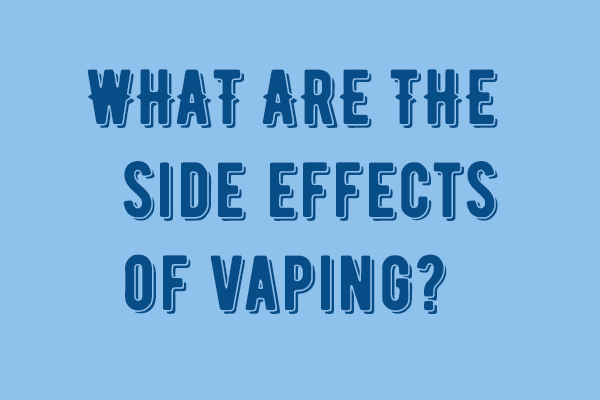
Vaping has a different side effect profile to smoking so it is worthwhile knowing the possible side effects when switching from smoking to vaping.
Vaping is very different from smoking. Now, that statement might seem completely obvious on the surface. Of course, vaping and smoking are different. If they weren’t, why would so many smokers be switching to vaping? One of the things you may not have considered, though, is that vaping is so different from smoking that it has an almost completely different side effect profile. It’s worthwhile to know those side effects in case you experience anything unusual during your switch from smoking to vaping.
So, what are the side effects of vaping?
The purpose of this article isn’t to discuss the possible long-term health outcomes of vaping; that’s beyond the scope of a single article, and the fact is that many of vaping’s long-term side effects are unknown and are still being studied by researchers. Most medical experts seem to agree that vaping is significantly less risky than smoking, though it is not entirely without risk.
Rather than discussing the potential long-term side effects of vaping, it’s our goal here to discuss the short-term side effects – the things that you might experience immediately or almost immediately after you start vaping. We want to help you understand what to expect and how to interpret anything abnormal that you might experience when you first quit smoking and start vaping.
Note: This article is intended for informational purposes only and is not medical advice. If you experience a side effect that you believe represents a potential medical concern, stop vaping immediately and contact your doctor for advice.
Coughing Is a Common Side Effect of Vaping for Quitters
If you were a long-time smoker before switching to vaping, you’re well aware of what it’s like to have a smoker’s cough. One surprising side effect of vaping, though, is that your coughing can actually increase in the short term when you first make the switch. According to Mayo Clinic, coughing is one of the most common symptoms that people experience when they quit smoking. That’s because the cilia – tiny hairs that help to keep your lungs clean – become more active when you stop smoking. Smoking slows the cilia down, and that makes it easier for tar to collect in your lungs. When you stop smoking, your lungs are going to want to clear that residue out as quickly as possible – and that’s why your coughing may increase.
If you’re a long-term smoker, you should expect to cough more frequently for at least the first few days after you switch to vaping. You should also expect to cough up some stuff that isn’t very attractive. It’s a good thing in the long run, though, because your lungs are becoming healthier. Mayo Clinic suggests that you should seek medical advice if you cough up blood or if the increased coughing lasts longer than a month.
Your Mouth May Feel Dry When You Switch to Vaping
The two most plentiful ingredients in most e-liquids are propylene glycol and vegetable glycerine. Much of what you inhale when vaping, therefore, will be those two substances in vapour form. That’s obviously the primary thing that makes vaping so different from smoking, and it’s also the reason why vaping is thought to be so much less risky than smoking. Inhaling the products of combustion is, above all else, the thing that makes smoking as deadly as it is.
With that said, propylene glycol and vegetable glycerine may cause a side effect of their own because they both absorb and trap moisture from the surrounding environment. That’s why they’re both common ingredients in lotions and other skincare products. If you put propylene glycol or vegetable glycerine on your skin, it’ll absorb water from the air, and your skin will feel moist as a result. For that same reason, though, dehydration and dryness in the mouth and throat are two of the most common side effects of vaping. Drinking plenty of water is always a good idea for health regardless of the circumstances, but you should really make a special effort to keep yourself hydrated when you switch to vaping.
Nicotine Consumption Has Its Own Side Effects
Regardless of the way in which you use it, nicotine consumption has its own side effects. That’s one reason why medical experts are hesitant to call vaping safe in absolute terms – because nicotine itself isn’t completely safe. For one thing, it’s known that nicotine is harmful to the developing bodies of adolescents. That’s why vaping is only to be used as an alternative to tobacco use for adult smokers who can’t or won’t quit. These are a few of the other side effects of all forms of nicotine use.
·Dependence and addiction
·Increased heart rate
·Reduced sleep quality
·Headaches
·Increased blood glucose levels
·Potential issues during foetal development and breastfeeding
Nicotine use can also have side effects if you aren’t consuming as much nicotine as you normally would. A sudden decrease in nicotine consumption can cause withdrawal symptoms, and those symptoms include difficulty concentrating, irritability, anxiety, stress and poor mood. If you experience those symptoms when vaping, it’s likely that the nicotine strength of your e-liquid is too low or that you aren’t vaping often enough to feel satisfied. Try a higher nicotine strength or vape a little more often, and your cravings for nicotine should subside.
You may also feel irritable or anxious if you consume too much nicotine. Some of the other side effects of nicotine overconsumption include vomiting, nausea, diarrhea, increased salivation and perspiration. Although it’s unlikely that you’ll ever consume enough nicotine from vaping to experience those side effects, it’s still worthwhile to be aware of those symptoms because they are sure signs that you’ve consumed too much nicotine and need to stop. If you ever experience symptoms of potential nicotine poisoning, you should contact a doctor right away.
Propylene Glycol Allergy Is a Possible Vaping Side Effect
The final potential side effect of vaping that we’ll discuss in this article is propylene glycol allergy. Propylene glycol is one of the main ingredients of e-liquid, and it’s also a common ingredient in a wide variety of consumer products including natural and artificial flavours, powdered drink mixes, snacks, shampoos, lotions, eyedrops, cosmetics, deodorants, medications and more. It’s also commonly added to tobacco products to prevent those products from drying out.
Unless you’re specifically trying to avoid propylene glycol, in other words, it’s likely that you consume or come into contact with it every day. A few people are allergic to propylene glycol, but PG allergies are rare. If you were allergic to propylene glycol, it’s likely that you would already know that before you started vaping.
We list PG allergy among the possible side effects of vaping, though, because there is one major difference between e-liquid and other common products that contain propylene glycol: There’s a lot more PG in e-liquid than in most other consumer products, which contain only small amounts. For that reason, there is a minute possibility that you could discover a previously unknown PG allergy by switching to vaping.
For vapers, some of the common symptoms of PG allergy include persistent coughing when vaping, sore throat and itchiness or bumpiness around the mouth. If you experience any of those symptoms when vaping, you should try buying an e-liquid that uses 100-percent vegetable glycerine as a base. If your symptoms subside, then it might be wise for you to avoid e-liquids containing PG. You can also ask your doctor to order a test confirming that you have a PG allergy.
If your PG allergy is severe, it’s always a good idea to contact an e-liquid maker before trying that brand’s products for the first time. PG-based flavours are very common, and you’ll want to confirm that the brand you’re considering buying doesn’t use PG-based flavours in its products.
